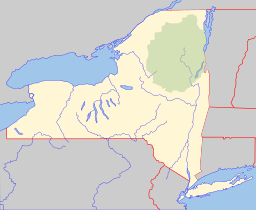
Back بحيرة جورج (نيويورك) Arabic بحيره چورچ ARZ Llac George (estat de Nova York) Catalan Lake George (lanaw sa Tinipong Bansa, New York, Warren County, lat 43,60, long -73,58) CEB Llyn George Welsh Lake George (New York) German Lac George (New York) French Lago George (New York) Italian ジョージ湖 (ニューヨーク州) Japanese 조지호 (뉴욕주) Korean
| Lake George | |
|---|---|
 Above Cook's Bay, facing south | |
| Location | Adirondack Mountains, Warren / Essex counties, New York, U.S. |
| Coordinates | 43°37′20″N 73°32′48″W / 43.62222°N 73.54667°W |
| Primary inflows | Streams 55%, Precipitation on lake surface 27%, groundwater 18% |
| Primary outflows | La Chute River |
| Basin countries | United States |
| Max. length | 32.2 mi (51.8 km) |
| Max. width | 3 mi (4.8 km) |
| Surface area | 45 sq mi (120 km2) |
| Average depth | 70 ft (21 m) |
| Max. depth | 196 ft (60 m) |
| Water volume | .597 cu mi (2.49 km3) (88 billion cubic feet) |
| Surface elevation | 320 ft (98 m) |
| Islands | Over 170 (172-178) |
| Settlements | Lake George, Ticonderoga, Bolton Landing, Huletts Landing |



Lake George, nicknamed the Queen of American Lakes,[2] is a long, narrow oligotrophic lake located at the southeast base of the Adirondack Mountains, in the northeastern portion of the U.S. state of New York. It lies within the upper region of the Great Appalachian Valley and drains all the way northward into Lake Champlain and the St. Lawrence River drainage basin. The lake is situated along the historical natural (Amerindian) path between the valleys of the Hudson and St. Lawrence Rivers, and so lies on the direct land route between Albany, New York, and Montreal, Quebec, Canada. The lake extends about 32.2 mi (51.8 km) on a north–south axis, is 187 ft (57 m) deep,[3] and ranges from one to three miles (1.6 to 4.8 km) in width, presenting a significant barrier to east–west travel. Although the year-round population of the Lake George region is relatively small, the summertime population can swell to over 50,000 residents, many in the village of Lake George region at the southern end of the lake.[not verified in body]
Lake George drains into Lake Champlain to its north through a short stream, the La Chute River, with many falls and rapids, dropping 226 feet (69 m) in its 3.5-mile (5.6 km) course—virtually all of which is within the lands of Ticonderoga, New York, and near the site of Fort Ticonderoga. Ultimately the waters flowing via the 106-mile-long (171 km) Richelieu River drain into the St. Lawrence River downstream and northeast of Montreal, and then into the North Atlantic Ocean Nova Scotia.
- ^ "Lake George". Museo Nacional Thyssen-Bornemisza.
- ^ See:
- Bolton Landing Chamber of Commerce, Visit Lake George Archived 2008-05-18 at the Wayback Machine, Retrieved May 12, 2008
- Albany International Airport, AIRPORT GALLERY FEATURES LAKE GEORGE "QUEEN OF AMERICAN LAKES" Archived 2008-05-16 at the Wayback Machine, 2004. Retrieved May 12, 2008
- The Hyde Collection, Painting Lake George: 1774 - 1900 Archived 2010-11-25 at the Wayback Machine, September, 2005. Retrieved May 12, 2008; Erin Budis Coe and Gwendolyn Owens,
- Painting Lake George 1774-1900, Syracuse University Press, 2005
- ^ "Lake George". dec.ny.gov. Archived from the original on 1 November 2019. Retrieved 9 March 2020.

